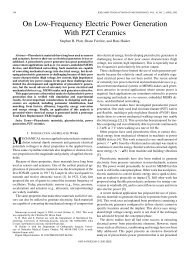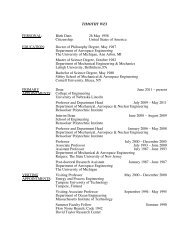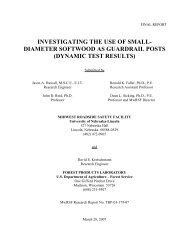Download .pdf of this edition. - College of Engineering - The ...
Download .pdf of this edition. - College of Engineering - The ...
Download .pdf of this edition. - College of Engineering - The ...
Create successful ePaper yourself
Turn your PDF publications into a flip-book with our unique Google optimized e-Paper software.
y Ashley Washburn, '02<br />
Farm equipment has changed dramatically<br />
since the University <strong>of</strong> Nebraska–Lincoln<br />
Tractor Test Laboratory poured its first<br />
concrete track in 1956. That one replaced the<br />
original track made <strong>of</strong> compacted soil.<br />
In the summer <strong>of</strong> 2007, the aging track was<br />
demolished and replaced with a new one that can<br />
better accommodate modern tractors, which are<br />
wider, heavier and faster than their predecessors.<br />
<strong>The</strong> new track is made from a special concrete<br />
blend that is 12 percent stronger than the concrete<br />
used for airport runways, said Roger Hoy,<br />
pr<strong>of</strong>essor <strong>of</strong> agricultural engineering and director<br />
<strong>of</strong> the lab.<br />
14. Spring20.0.8<br />
<strong>The</strong> track also is wider and thicker than the<br />
original 22 feet wide, compared to 15, and nine<br />
inches thick instead <strong>of</strong> seven. <strong>The</strong> new track also<br />
features banked edges that will allow the lab to test<br />
tractors that travel at higher speeds.<br />
<strong>The</strong>se advancements will make it possible for the<br />
lab to test a wider variety <strong>of</strong> tractors. For example,<br />
Hoy said, his staff was able to test a Case IH<br />
tractor that would have been too wide and heavy<br />
to fit on the old track. In the past, the team would<br />
have tested that machine at the<br />
Lincoln Airport.<br />
Construction on the track began<br />
shortly after Memorial Day and<br />
concluded in August. HWS<br />
Consulting Group, the Lincoln<br />
engineering firm that designed<br />
the original track, also designed<br />
the new one. Another Lincoln<br />
company, TCW Construction, built the new track.<br />
Hoy said he hoped the track would last another<br />
50 years.<br />
“We tried to anticipate what needs we would have<br />
in the future,” he said.<br />
UNL is the only university in the United States to<br />
have a tractor test lab, which was formed because a<br />
state senator purchased a tractor and was unhappy<br />
with its performance. Wilmot Crozier introduced<br />
a bill in the 1918 Legislature requiring any<br />
tractor sold in Nebraska to be tested to ensure it<br />
performed as the manufacturer claimed. Thus, the<br />
Tractor Test Lab opened in 1919.<br />
Nebraska is still the only state to have such a law,<br />
Hoy said, but almost all models are evaluated<br />
at the lab anyway. <strong>The</strong> lab also<br />
is the <strong>of</strong>ficial U.S. testing site for<br />
the Organization for Economic<br />
Cooperation and Development,<br />
which regulates tractor standards<br />
worldwide.<br />
On average, the lab tests 25 tractors<br />
annually. <strong>The</strong> lab’s operation and<br />
maintenance costs, including<br />
construction <strong>of</strong> the new track, are funded through<br />
manufacturers’ fees.<br />
Ed Heys <strong>of</strong> the Association <strong>of</strong> Equipment<br />
Manufacturers said the lab is one <strong>of</strong> the finest <strong>of</strong> its<br />
kind in the world, and added; “<strong>The</strong>ir future looks<br />
bright—and busy.”







